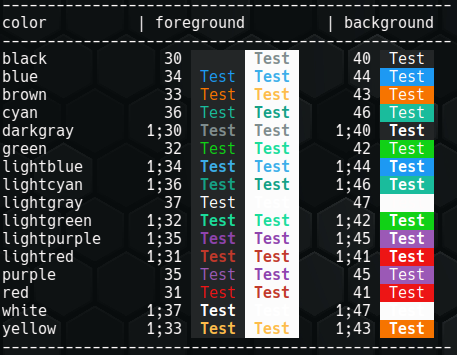Table of Contents
Colors
How to define colors
When using colors there are multiple ways.
Color names
These colors you get from the color.list (see below).
- black
- blue
- brown
- cyan
- darkgray
- green
- lightblue
- lightcyan
- lightgray
- lightgreen
- lightpurple
- lightred
- purple
- red
- white
- yellow
These builtuin color names are not standard. But they are more simple to handle than fiddly ansi color values and create readable color codes.
This is the recommended method.
Examples:
Set cyan foreground:
color.fg "cyan"
Set white background:
color.bg "white"
RGB hex code
If you are familiar with css color hexcodes you may like this syntax.
- use a
#as prefix - followed by 2 digits for the colors red, green and blue; the shorter 3 digit rgb code is NOT supported.
Example:
Set a blue background:
color.bg "#10404f"
Ansi values
If you are familiar with the ansi color codes already you can set white as “1;47” or cyan as “36”
Examples:
Set cyan foreground:
color.fg "36"
Set white background:
color.bg "1;47"
Basic colors (0..7)
This can set only the foreground colors 30 to 37 and background colors 40 to 47. Do not to care about the different ranges for foreground and background - the prefix ‘3’ (foreground) or ‘4’ (background) will be set internally by the used function.
- 0 - black
- 1 - red
- 2 - green
- 3 - brown
- 4 - blue
- 5 - purple
- 6 - cyan
- 7 - gray
Examples:
Set cyan foreground:
color.fg "6"
Set gray background:
color.bg "7"`
List
To see the colors, names or ansi code you can call color.list
